engine Lexus IS250 2006 Using the audio system / LEXUS 2006 IS350/250 THROUGH APRIL 2006 PROD. (OM53508U) Owner's Guide
[x] Cancel search | Manufacturer: LEXUS, Model Year: 2006, Model line: IS250, Model: Lexus IS250 2006Pages: 433, PDF Size: 10.9 MB
Page 65 of 433

47
1
Before driving
1-5. Refueling
Opening the fuel tank cap
Perform the following steps to open the fuel tank cap.
■Before refueling the vehicle
Turn the engine switch OFF and e nsure that all the doors and win-
dows are closed.
■ Opening the fuel tank cap
Open the fuel filler door.
Turn the fuel tank cap slowly to
open.
Hang the fuel tank cap on the
back of the fuel filler door.
STEP1
STEP2
STEP3
Page 68 of 433

50
1-6. Anti-theft system
Engine immobilizer system
■Conditions that may cause the system to malfunction
●If the grip portion of the key is in contact with a metallic object
●If the key is in close proximity to or touching a key to the security system (key
with a built-in transponder chip) of another vehicle
■Certifications for the engine immobilizer system For vehicles sold in the U.S.A.
FCC ID: NI4TMIMB-1
This device complies with Part 15 of the FCC Rules. Operation is subject to the fol-
lowing two conditions: (1) this device may not cause harmful interference, and (2)
this device must accept any interference received, including interference that may
cause undesired operation.
For vehicles sold in Canada
Operation is subject to the following two conditions: (1) this device may not cause
interference, and (2) this device must accept any interference, including interfer-
ence that may cause undesired operation of the device.
The vehicle's keys have built-in transponder chips that prevent the engine
from starting if the key has not been previously registered in the vehicle's
on-board computer.
The indicator light flashes after
the engine switch has been
turned OFF to indicate that the
system is operating.
Page 69 of 433
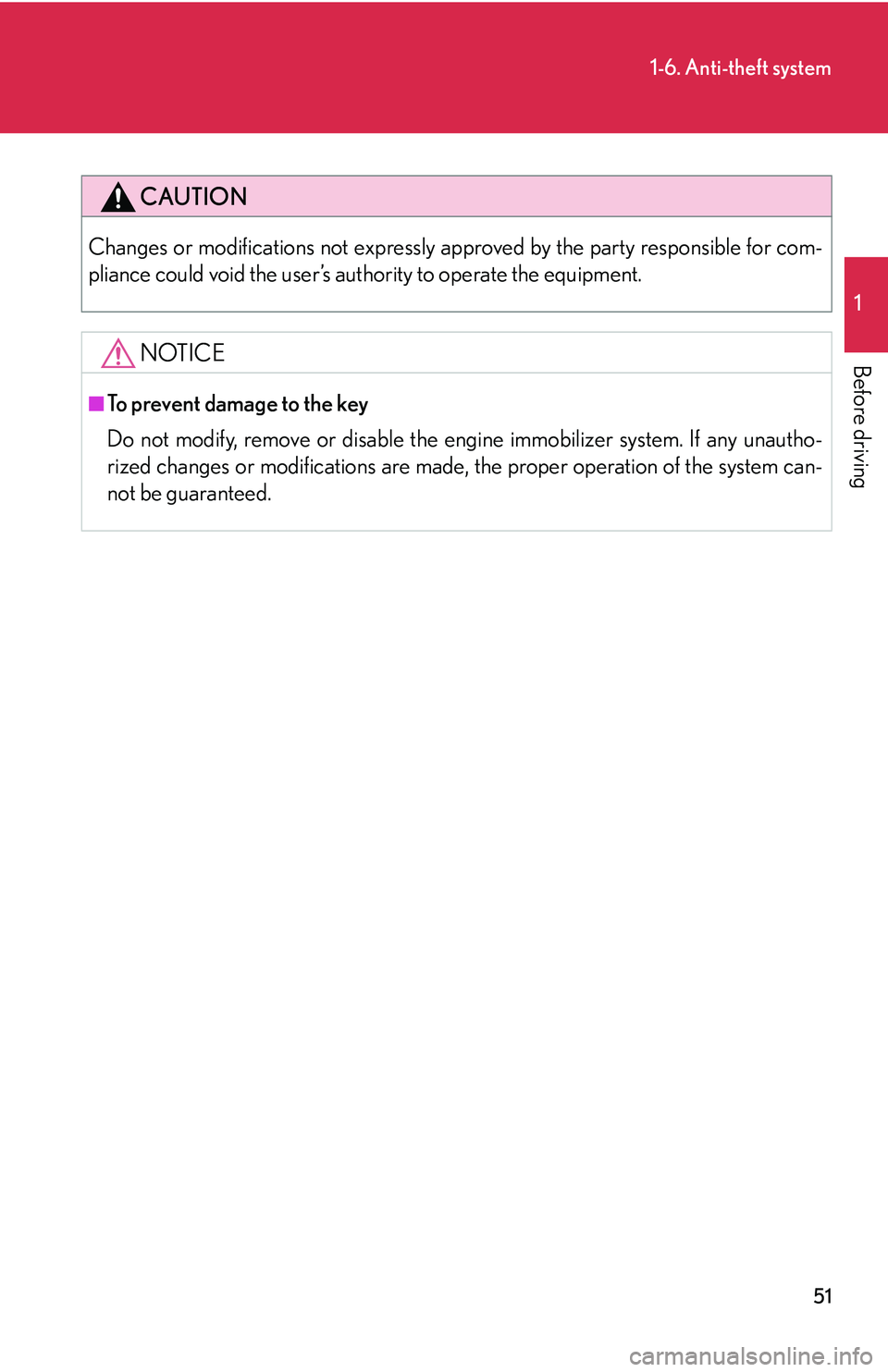
51
1-6. Anti-theft system
1
Before driving
CAUTION
Changes or modifications not expressly approved by the party responsible for com-
pliance could void the user’s authority to operate the equipment.
NOTICE
■To prevent damage to the key
Do not modify, remove or disable the engine immobilizer system. If any unautho-
rized changes or modifications are made, the proper operation of the system can-
not be guaranteed.
Page 70 of 433
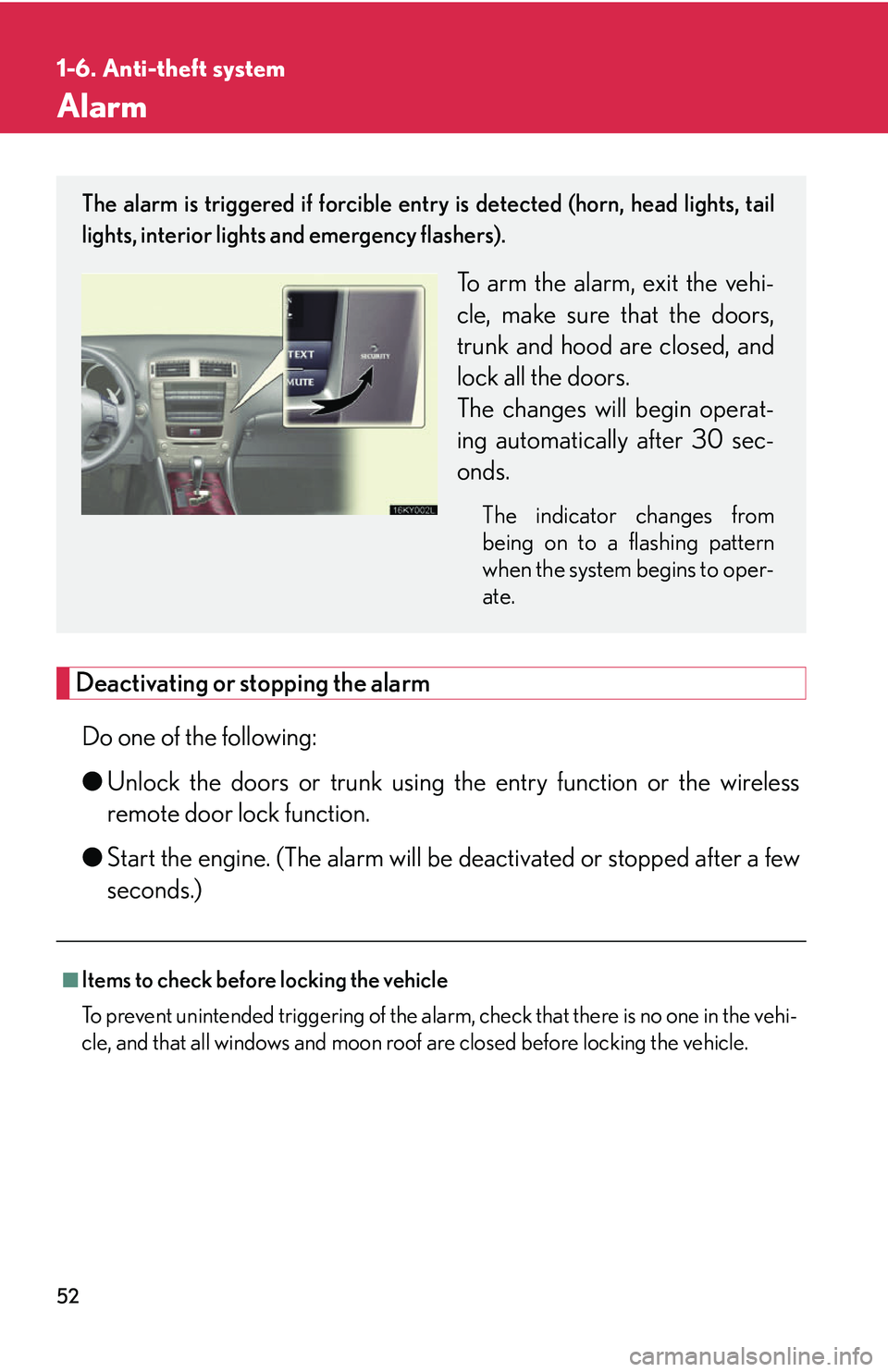
52
1-6. Anti-theft system
Alarm
Deactivating or stopping the alarmDo one of the following:
● Unlock the doors or trunk using th e entry function or the wireless
remote door lock function.
● Start the engine. (The alarm will be deactivated or stopped after a few
seconds.)
■Items to check before locking the vehicle
To prevent unintended triggering of the alar m, check that there is no one in the vehi-
cle, and that all windows and moon roof are closed before locking the vehicle.
The alarm is triggered if forcible entry is detected (horn, head lights, tail
lights, interior lights and emergency flashers).
To arm the alarm, exit the vehi-
cle, make sure that the doors,
trunk and hood are closed, and
lock all the doors.
The changes will begin operat-
ing automatically after 30 sec-
onds.
The indicator changes from
being on to a flashing pattern
when the system begins to oper-
ate.
Page 99 of 433
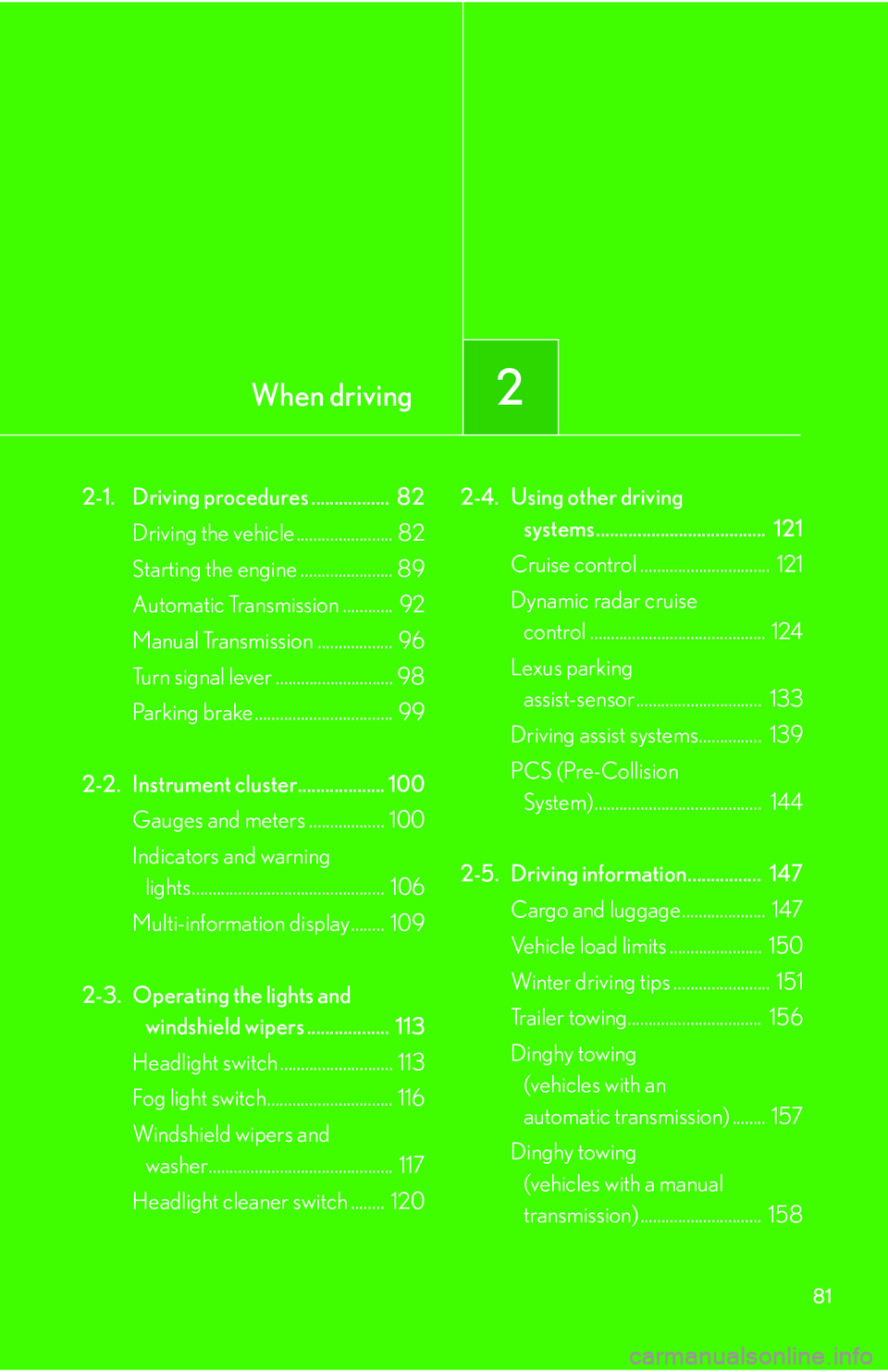
When driving2
81
2-1. Driving procedures ................. 82Driving the vehicle ....................... 82
Starting the engine ...................... 89
Automatic Transmission ............ 92
Manual Transmission .................. 96
Turn signal lever ............................ 98
Parking brake ................................. 99
2-2. Instrument cluster................... 100 Gauges and meters .................. 100
Indicators and warning lights.............................................. 106
Multi-information display........ 109
2-3. Operating the lights and windshield wipers .................. 113
Headlight switch ........................... 113
Fog light switch.............................. 116
Windshield wipers and washer............................................ 117
Headlight cleaner switch ........ 120 2-4. Using other driving
systems ..................................... 121
Cruise control ............................... 121
Dynamic radar cruise control .......................................... 124
Lexus parking assist-sensor .............................. 133
Driving assist systems............... 139
PCS (Pre-Collision System)........................................ 144
2-5. Driving information................ 147 Cargo and luggage.................... 147
Vehicle load limits ...................... 150
Winter driving tips ....................... 151
Trailer towing................................ 156
Dinghy towing (vehicles with an
automatic transmission) ........ 157
Dinghy towing (vehicles with a manual
transmission) ............................. 158
Page 100 of 433
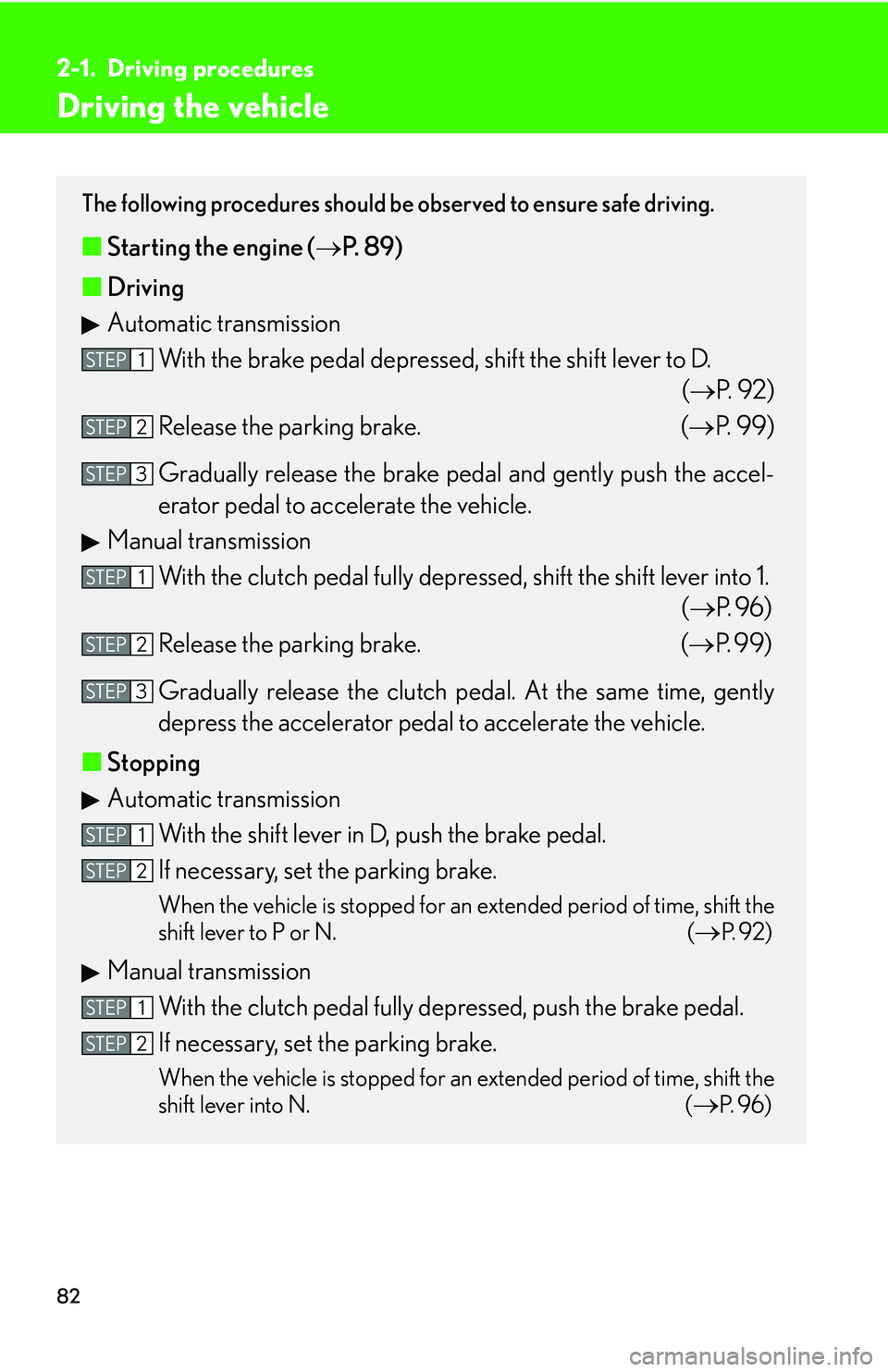
82
2-1. Driving procedures
Driving the vehicle
The following procedures should be observed to ensure safe driving.
■Starting the engine ( P. 8 9 )
■ Driving
Automatic transmission
With the brake pedal depressed, shift the shift lever to D. (P. 9 2 )
Release the parking brake. ( P. 99)
Gradually release the brake peda l and gently push the accel-
erator pedal to accelerate the vehicle.
Manual transmission
With the clutch pedal fully depressed, shift the shift lever into 1. (P. 9 6 )
Release the parking brake. ( P. 99)
Gradually release the clutch pedal. At the same time, gently
depress the accelerator pedal to accelerate the vehicle.
■ Stopping
Automatic transmission
With the shift lever in D, push the brake pedal.
If necessary, set the parking brake.
When the vehicle is stopped for an extended period of time, shift the
shift lever to P or N. (
P. 9 2 )
Manual transmissionWith the clutch pedal fully depressed, push the brake pedal.
If necessary, set the parking brake.
When the vehicle is stopped for an extended period of time, shift the
shift lever into N. (
P. 9 6 )
STEP1
STEP2
STEP3
STEP1
STEP2
STEP3
STEP1
STEP2
STEP1
STEP2
Page 101 of 433

83
2-1. Driving procedures
2
When driving
Starting on a steep inclineAutomatic transmission Firmly set the parking brake and shift the shift lever to D.
Gently depress the accelerator pedal.
Release the parking brake.
Manual transmission
With the parking brake firmly set and the clutch pedal fully
depressed, shift the shift lever into 1.
Lightly depress the accelerator pedal at the same time as gradu-
ally releasing the clutch pedal.
Release the parking brake.
■ Parking the vehicle
Automatic transmission
With the shift lever in D, push the brake pedal.
Set the parking brake. ( P. 99)
Shift the shift lever to P. ( P. 9 2 )
Stop the engine.
Lock the door, making sure that you have the electronic key on
your person.
Manual transmission With the clutch pedal fully depressed, push the brake pedal.
Set the parking brake. ( P. 99)
Shift the shift lever into N. ( P. 9 6 )
Stop the engine.
Lock the door, making sure that you have the electronic key on
your person.
STEP1
STEP2
STEP3
STEP4
STEP5
STEP1
STEP2
STEP3
STEP4
STEP5
STEP1
STEP2
STEP3
STEP1
STEP2
STEP3
Page 102 of 433
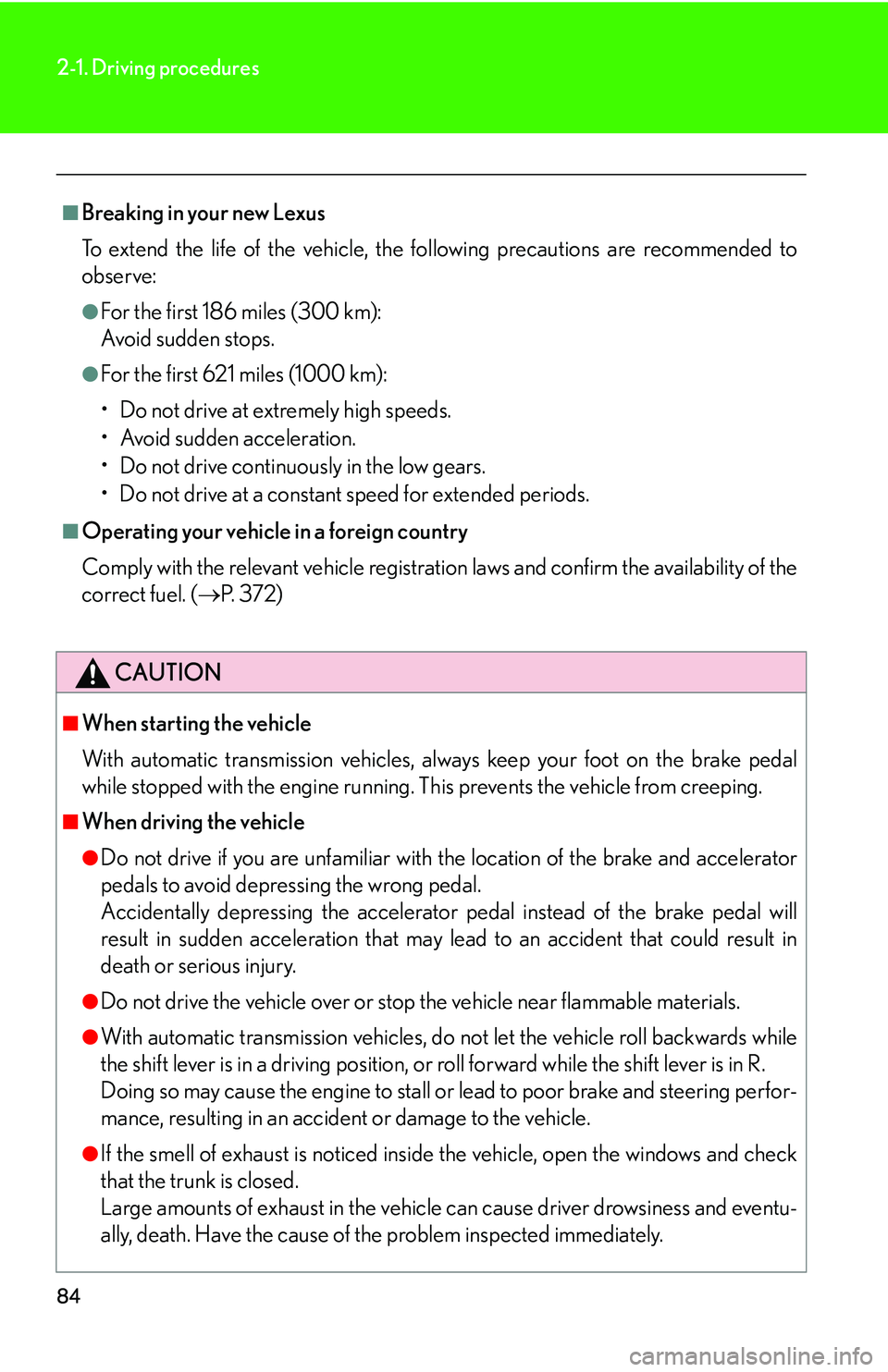
84
2-1. Driving procedures
■Breaking in your new Lexus
To extend the life of the vehicle, the following precautions are recommended to
observe:
●For the first 186 miles (300 km):
Avoid sudden stops.
●For the first 621 miles (1000 km):
• Do not drive at extremely high speeds.
• Avoid sudden acceleration.
• Do not drive continuously in the low gears.
• Do not drive at a constant speed for extended periods.
■Operating your vehicle in a foreign country
Comply with the relevant vehicle registration laws and confirm the availability of the
correct fuel. (P. 3 7 2 )
CAUTION
■When starting the vehicle
With automatic transmission vehicles, always keep your foot on the brake pedal
while stopped with the engine running. This prevents the vehicle from creeping.
■When driving the vehicle
●Do not drive if you are unfamiliar with the location of the brake and accelerator
pedals to avoid depressing the wrong pedal.
Accidentally depressing the accelerator pedal instead of the brake pedal will
result in sudden acceleration that may le ad to an accident that could result in
death or serious injury.
●Do not drive the vehicle over or stop the vehicle near flammable materials.
●With automatic transmission vehicles, do not let the vehicle roll backwards while
the shift lever is in a driving position, or roll forward while the shift lever is in R.
Doing so may cause the engine to stall or lead to poor brake and steering perfor-
mance, resulting in an accident or damage to the vehicle.
●If the smell of exhaust is noticed inside the vehicle, open the windows and check
that the trunk is closed.
Large amounts of exhaust in the vehicle can cause driver drowsiness and eventu-
ally, death. Have the cause of the problem inspected immediately.
Page 103 of 433
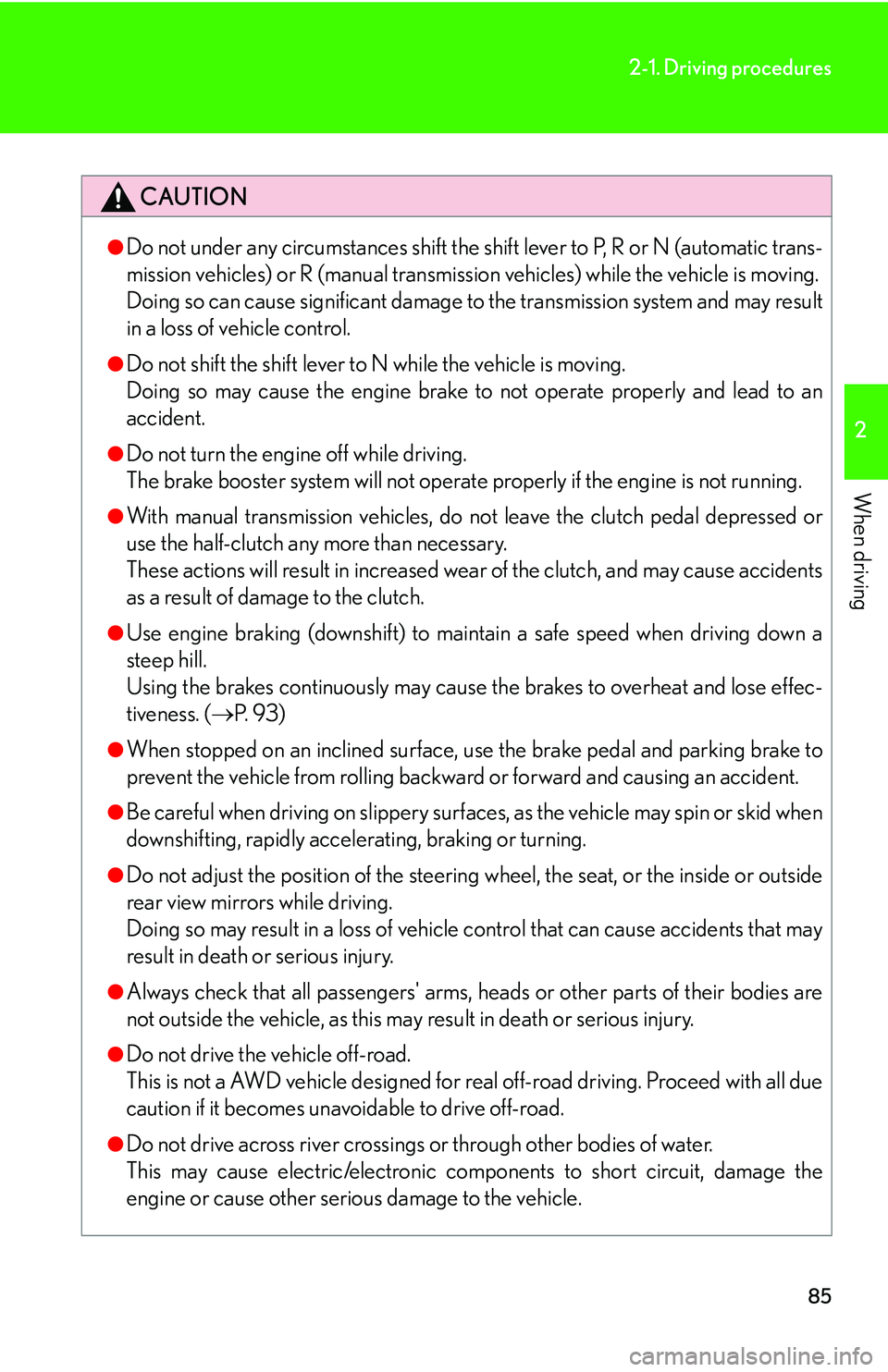
85
2-1. Driving procedures
2
When driving
CAUTION
●Do not under any circumstances shift the shift lever to P, R or N (automatic trans-
mission vehicles) or R (manual transmission vehicles) while the vehicle is moving.
Doing so can cause significant damage to the transmission system and may result
in a loss of vehicle control.
●Do not shift the shift lever to N while the vehicle is moving.
Doing so may cause the engine brake to not operate properly and lead to an
accident.
●Do not turn the engine off while driving.
The brake booster system will not operate properly if the engine is not running.
●With manual transmission vehicles, do not leave the clutch pedal depressed or
use the half-clutch any more than necessary.
These actions will result in increased wear of the clutch, and may cause accidents
as a result of damage to the clutch.
●Use engine braking (downshift) to maintain a safe speed when driving down a
steep hill.
Using the brakes continuously may cause the brakes to overheat and lose effec-
tiveness. ( P. 9 3 )
●When stopped on an inclined surface, use the brake pedal and parking brake to
prevent the vehicle from rolling backward or forward and causing an accident.
●Be careful when driving on slippery surfaces, as the vehicle may spin or skid when
downshifting, rapidly accelerating, braking or turning.
●Do not adjust the position of the steering wheel, the seat, or the inside or outside
rear view mirrors while driving.
Doing so may result in a loss of vehicle control that can cause accidents that may
result in death or serious injury.
●Always check that all passengers' arms, heads or other parts of their bodies are
not outside the vehicle, as this may result in death or serious injury.
●Do not drive the vehicle off-road.
This is not a AWD vehicle designed for real off-road driving. Proceed with all due
caution if it becomes unavoidable to drive off-road.
●Do not drive across river crossings or through other bodies of water.
This may cause electric/electronic comp onents to short circuit, damage the
engine or cause other serious damage to the vehicle.
Page 104 of 433
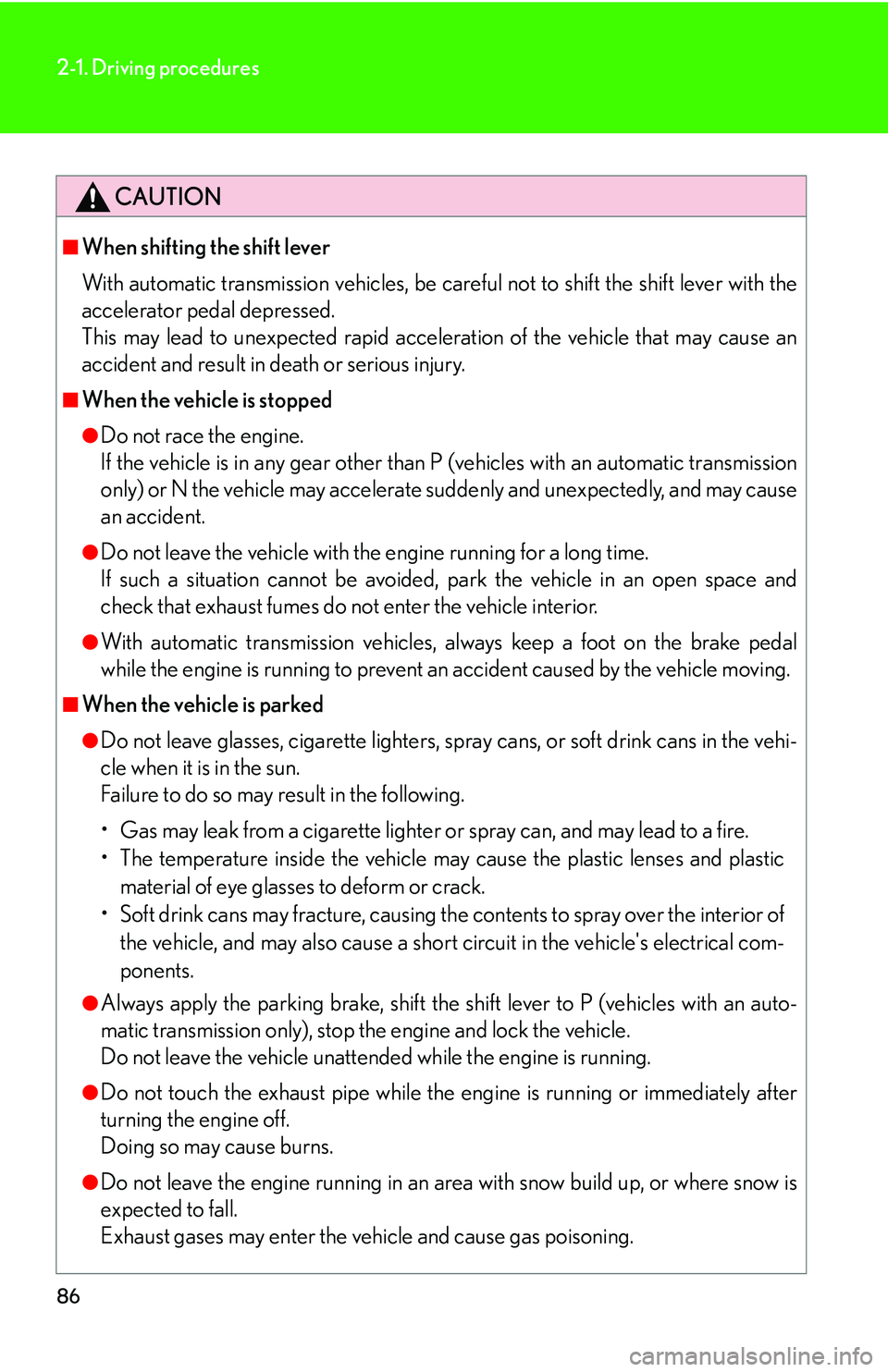
86
2-1. Driving procedures
CAUTION
■When shifting the shift lever
With automatic transmission vehicles, be careful not to shift the shift lever with the
accelerator pedal depressed.
This may lead to unexpected rapid acceleration of the vehicle that may cause an
accident and result in death or serious injury.
■When the vehicle is stopped
●Do not race the engine.
If the vehicle is in any gear other than P (vehicles with an automatic transmission
only) or N the vehicle may accelerate suddenly and unexpectedly, and may cause
an accident.
●Do not leave the vehicle with the engine running for a long time.
If such a situation cannot be avoided, park the vehicle in an open space and
check that exhaust fumes do no t enter the vehicle interior.
●With automatic transmission vehicles, always keep a foot on the brake pedal
while the engine is running to prevent an accident caused by the vehicle moving.
■When the vehicle is parked
●Do not leave glasses, cigarette lighters, spray cans, or soft drink cans in the vehi-
cle when it is in the sun.
Failure to do so may result in the following.
• Gas may leak from a cigarette lighter or spray can, and may lead to a fire.
• The temperature inside the vehicle may cause the plastic lenses and plastic material of eye glasses to deform or crack.
• Soft drink cans may fracture, causing the contents to spray over the interior of
the vehicle, and may also cause a short circuit in the vehicle's electrical com-
ponents.
●Always apply the parking brake, shift the shift lever to P (vehicles with an auto-
matic transmission only), stop the engine and lock the vehicle.
Do not leave the vehicle unattend ed while the engine is running.
●Do not touch the exhaust pipe while the engine is running or immediately after
turning the engine off.
Doing so may cause burns.
●Do not leave the engine running in an area with snow build up, or where snow is
expected to fall.
Exhaust gases may enter the vehicle and cause gas poisoning.